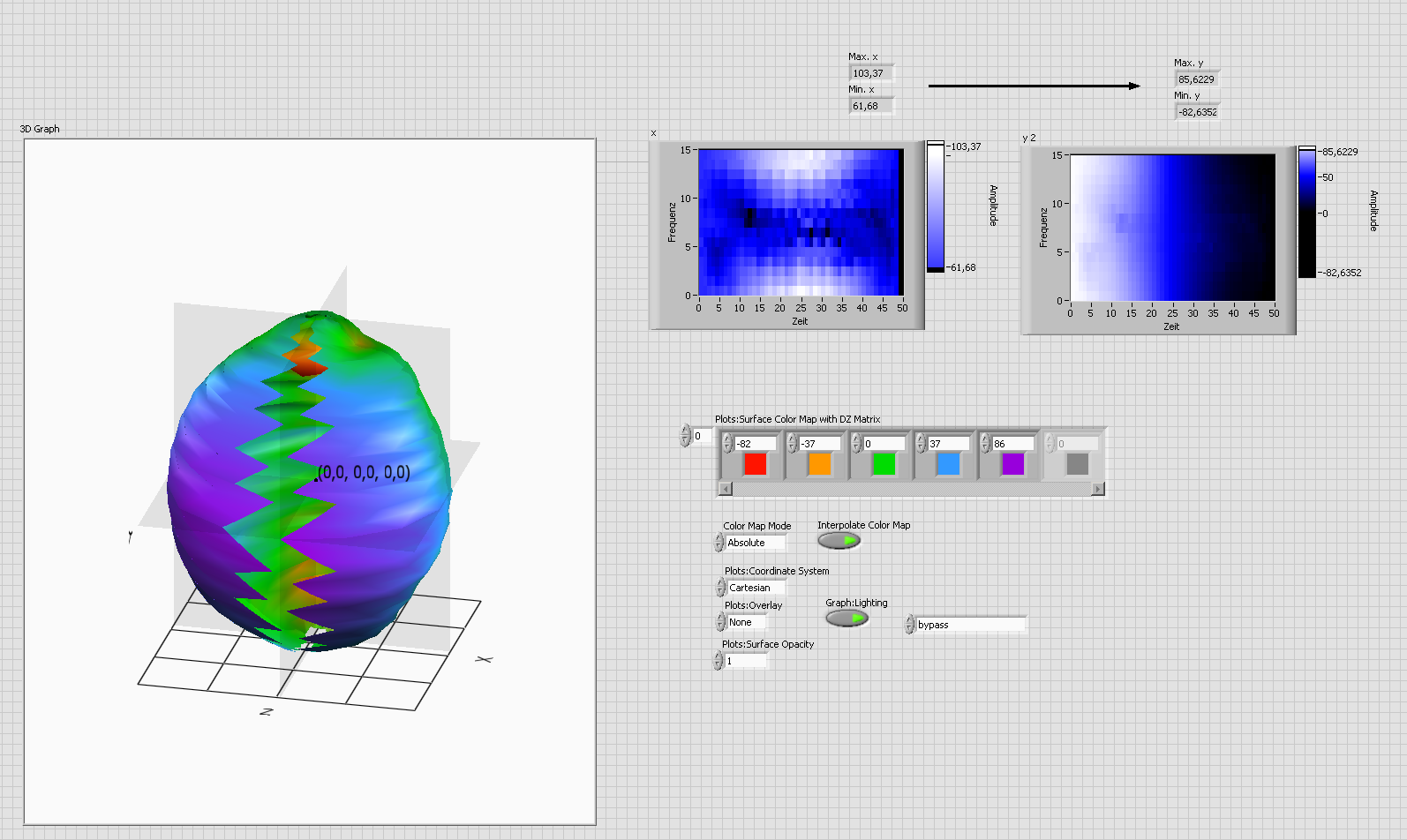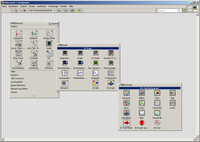- Subscribe to RSS Feed
- Mark Topic as New
- Mark Topic as Read
- Float this Topic for Current User
- Bookmark
- Subscribe
- Mute
- Printer Friendly Page
- « Previous
- Next »
Balloon Plots
Solved!03-14-2017 10:17 AM
- Mark as New
- Bookmark
- Subscribe
- Mute
- Subscribe to RSS Feed
- Permalink
- Report to a Moderator
Look again at the example I posted for where the color ramp is being mapped. Using that, you can control to colors associated with each point. Also note that CW uses BGR not RGB colors.
Ben
03-14-2017 02:08 PM
- Mark as New
- Bookmark
- Subscribe
- Mute
- Subscribe to RSS Feed
- Permalink
- Report to a Moderator
Thanks Ben! I used your example to create a custom Color ramp to change the surface colors and it works great. I was just hoping to have a built-in solution that I do not have to code and maintain but this one works great as well. 🙂
alexderjuengere, yes, adding the first column to the last closes the surface and it looks good, but I am keeping it open for now so that the user knows where the 0 degree value is. I might close it if the user prefers it that way. Thanks!
- Tags:
- LabView_4d
03-15-2017 06:17 AM
- Mark as New
- Bookmark
- Subscribe
- Mute
- Subscribe to RSS Feed
- Permalink
- Report to a Moderator
@LVCoder wrote:
@alexderjuengere, yes, adding the first column to the last closes the surface and it looks good, but I am keeping it open for now so that the user knows where the 0 degree value is. I might close it if the user prefers it that way. Thanks!
yes, as an user I would also prefer to see where the 0 degree value is.
Furthermore, "with the lights off it's less dangerous" - certainly Kurt Cobain didn't refer to an 3d CW graph, but switching on the lights renders the closed 3d surface not so well:
@LVCoder wrote:
Thanks Ben! I used your example to create a custom Color ramp to change the surface colors and it works great. I was just hoping to have a built-in solution that I do not have to code and maintain but this one works great as well. 🙂
the newer version of the 3d cw graph does have a fourth dimension input "color matrix", but it doesn't quite behave as expected
03-15-2017 07:38 AM
- Mark as New
- Bookmark
- Subscribe
- Mute
- Subscribe to RSS Feed
- Permalink
- Report to a Moderator
@alexderjuengere wrote:
...
the newer version of the 3d cw graph does have a fourth dimension input "color matrix", but it doesn't quite behave as expected
Is that the "CW" as in "Component Works" or are you talking about the new LVOOP based 3D graph?
Set mode = Rant
While I was a fan of the CW version, the new LVOOP version made me throwing my hands up in the air and gave up trying. The early version where poorly documented, and performed terribly. It was another case of NI trying to introduce a new and improved version of something only to find out the developers of the new version having only a shallow understanding of the old version's capabilities and testing only with the most primitive simple examples.
Done with my rant!
Take care,
Ben
03-15-2017 07:54 AM - edited 03-15-2017 07:54 AM
- Mark as New
- Bookmark
- Subscribe
- Mute
- Subscribe to RSS Feed
- Permalink
- Report to a Moderator
@Ben wrote:
@alexderjuengere wrote:
the newer version of the 3d cw graph does have a fourth dimension input "color matrix", but it doesn't quite behave as expected
Is that the "CW" as in "Component Works" or are you talking about the new LVOOP based 3D graph?
During the propagation of this thread, I learned that there are two flavors of 3d Surface Graph.
It is possible to spwan a 3d graph via blockdiagram using
"..National Instruments\LabVIEW 2015\vi.lib\Platform\3dgraph.lib"
which is equivalent to:
or using a palette directly from the frontpanel:
With "newer 3d surface graph" I mean the frontpanel-flavor, which does behave a bit different than the classic blockdiagram-flavor
The frontpanel-flavor does have lot's of LVOOP components, but the core I suppose is still a CW graph.
03-15-2017 02:59 PM
- Mark as New
- Bookmark
- Subscribe
- Mute
- Subscribe to RSS Feed
- Permalink
- Report to a Moderator
Just to clarify...
The example shared by LVCoder is the CW version.
The example by Alex is the LVOOP version.
You can tell the difference by right-click the control on the FP and the CW version clearly says "Component Works". It has more properties and a preview window.
The LVOOP version has limited options.
When looking at the diagram the LVOOP version has a LVOOP wire and he CW version has a simple reference wire.
Nice to know the CW version still works. I had gotten the idea that it was no longer supported!
Ben
03-17-2017 12:52 PM
- Mark as New
- Bookmark
- Subscribe
- Mute
- Subscribe to RSS Feed
- Permalink
- Report to a Moderator
I am able to create the correct color map on the LVOOP version of the surface graph. There's a property called "Color Map Mode" which I set to Relative and not it corresponds the color value directly with the decibel values that I put in the color matrix input.
In the CW version of the graph, the cursor lines stick out of the surface of the plot which helps in determining the center point of plot but cursor lines in the LVOOP version are the same length as the radius of the sphere which makes it harder to determine the center point of plot.
03-17-2017 01:37 PM
- Mark as New
- Bookmark
- Subscribe
- Mute
- Subscribe to RSS Feed
- Permalink
- Report to a Moderator
@LVCoder wrote:
I am able to create the correct color map on the LVOOP version of the surface graph. There's a property called "Color Map Mode" which I set to Relative and not it corresponds the color value directly with the decibel values that I put in the color matrix input.
In the CW version of the graph, the cursor lines stick out of the surface of the plot which helps in determining the center point of plot but cursor lines in the LVOOP version are the same length as the radius of the sphere which makes it harder to determine the center point of plot.
a user can change the surface plot's opacity at runtime via the plot's right-click context menu
e.g. opacity = 0.8 looks like this:
this property can also be set programmatically
- « Previous
- Next »





